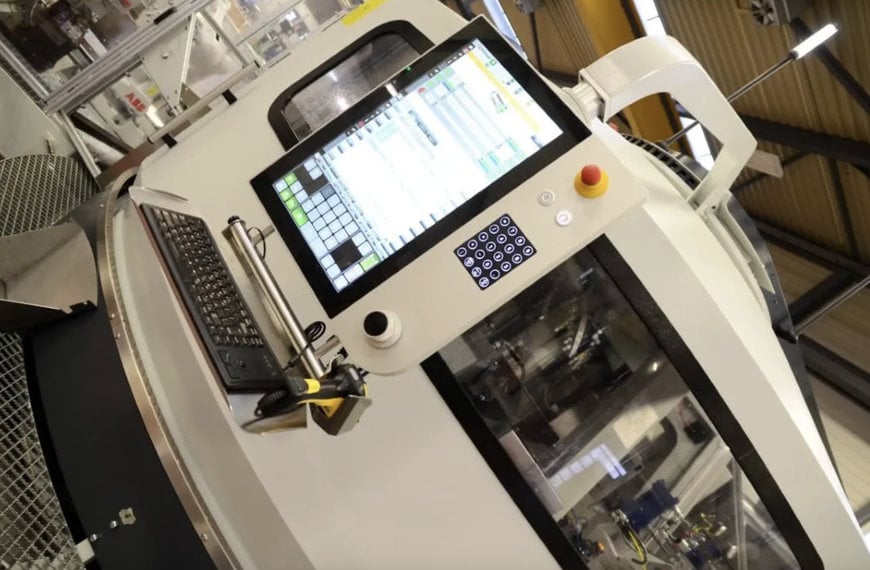www.ptreview.co.uk
10
'24
Written on Modified on
KEBA: Redefining standards in modern machine operation with the KeWheel
For machine builders looking for a solution that combines precision, flexibility and ease of use, the KeWheel is the next big step in the evolution of machine operation.
www.keba.com

In industrial automation, precision, efficiency, and user-friendliness are crucial. Innovative control concepts, especially in the machine tool industry, enhance productivity through optimized human-machine interfaces.
The operation of modern machines is complex. Many companies in the field of industrial automation are faced with the same questions:
- How can precision and user-friendliness be combined?
- How can analog and digital controls be sensibly combined?
- How can human-machine interaction remain efficient without losing flexibility?
Answering these critical questions poses major challenges for machine manufacturers. Productivity depends to a large extent on intuitive and precise control. In industries such as machine tool manufacturing, a suboptimal operating solution can slow down the entire work process or, in the worst case, even impair the quality of the results.
The biggest challenges in machine operation
The biggest challenges in machine operation
- Lack of tactile feedback: Many digital control elements have no haptic feedback, which means that operators lose important feedback about the status of the machine. This leads to uncertainty and potential control errors.
- Complexity and confusion: Multiple operating elements for different functions increase the complexity of operation. This not only makes the operator's work more difficult and requires a high level of training, but also increases training times.
- Difficult integration into existing systems: New technologies are often difficult to integrate into existing machines and control systems, resulting in high costs and long implementation times.
- Limited adaptability: Standardized operating solutions rarely offer the flexibility that machine builders and operators need for individual requirements.
This is precisely where KEBA comes in with its KeWheel – a special control element that combines analog input options with digital flexibility and has been optimized specifically for industrial applications. The concept of the KeWheel has the potential to fundamentally change the way we interact with automation because it represents the symbiosis of proven analog control and modern digital integration.
HMI Explained | Innovative HMI controls - The KeWheel
Digital integration without giving up tactile feedback
One special feature of the KeWheel is the option of digitally regulating analog values without the user missing the familiar physical feedback. Thanks to this function, the haptic experience remains, making the KeWheel similar to a mechanical handwheel in terms of operation. Users can adjust their controls without losing the comfort and precision offered by mechanical controls.
Multifunctionality and versatility for a wide range of requirements
One of the KeWheel's key advantages is its adaptability: a single device can simulate multiple operating elements and perform various control functions. This opens up new possibilities for developers and operators, as they can cover a wide range of tasks with just one device – from controlling a spindle feed to precise axis control on machine tools. This multifunctionality makes the KeWheel a future-proof choice for companies that require flexible and scalable HMI solutions.
Haptic feedback for more precision and ease of use
Compared to conventional HMIs, the KeWheel offers realistic haptic feedback that can be customized to the mechanical components of the control. For machine builders, this means they can customize the intensity of the haptic feedback to create a personalized user experience. This customizability is a significant advantage, especially for applications that require precision and dexterity, as is often the case in the field of machine tool control.

The KeWheel in use at machine tool manufacturer Pfiffner (see link to the success story at the end of the article)
Easy integration and compatibility with industry standards
The KeWheel is compatible with common bus systems, enabling seamless integration into existing systems. For users looking for a user-friendly solution, the KeWheel offers simple, standardized integration into industrial control environments without having to adapt the existing infrastructure. Supplementary integration guides help to quickly and securely integrate the KeWheel into new projects – a decisive advantage for companies that value efficiency and time savings.
Efficient communication and collaboration through networking
The KeWheel is more than just an isolated input device. Its ability to share values between different devices, enabling coordinated control, is particularly valuable for complex production environments. This networked functionality promotes collaboration between different systems and increases productivity by allowing operators to focus on controlling the system as a whole rather than individual components.
Time savings through optimized programming and operation
Another advantage of the KeWheel is the time saved in programming and operation. Its easy integration and multifunctional use eliminate the need to program and maintain multiple separate control elements. For companies, this means increased efficiency, as employees spend less time on setup and maintenance and can focus more on their core tasks.
The KeWheel is an impressive example of how well-thought-out innovation in industrial automation not only increases efficiency, but also puts the user experience at the center. For machine builders looking for a solution that combines precision, flexibility and ease of use, the KeWheel is the next big step in the evolution of machine operation.
KeWheel Success Stories
The way in which the KeWheel and its technology are integrated is demonstrated by the two German machine tool manufacturers Pfiffner and Schwäbische Werkzeugmaschinen. These companies have been successfully using the KeWheel for years. You can read about the pain points that were resolved and how the collaboration with KEBA went in the Success story of SW ("Machine operation under glass as a competitive advantage") and the Success Story of Pfiffner ("Rotary indexing machines: the next level in machine operation").
Learn more about KEBA's HMI Solutions
HMI Explained | Innovative HMI controls - The KeWheel
Digital integration without giving up tactile feedback
One special feature of the KeWheel is the option of digitally regulating analog values without the user missing the familiar physical feedback. Thanks to this function, the haptic experience remains, making the KeWheel similar to a mechanical handwheel in terms of operation. Users can adjust their controls without losing the comfort and precision offered by mechanical controls.
Multifunctionality and versatility for a wide range of requirements
One of the KeWheel's key advantages is its adaptability: a single device can simulate multiple operating elements and perform various control functions. This opens up new possibilities for developers and operators, as they can cover a wide range of tasks with just one device – from controlling a spindle feed to precise axis control on machine tools. This multifunctionality makes the KeWheel a future-proof choice for companies that require flexible and scalable HMI solutions.
Haptic feedback for more precision and ease of use
Compared to conventional HMIs, the KeWheel offers realistic haptic feedback that can be customized to the mechanical components of the control. For machine builders, this means they can customize the intensity of the haptic feedback to create a personalized user experience. This customizability is a significant advantage, especially for applications that require precision and dexterity, as is often the case in the field of machine tool control.

The KeWheel in use at machine tool manufacturer Pfiffner (see link to the success story at the end of the article)
Easy integration and compatibility with industry standards
The KeWheel is compatible with common bus systems, enabling seamless integration into existing systems. For users looking for a user-friendly solution, the KeWheel offers simple, standardized integration into industrial control environments without having to adapt the existing infrastructure. Supplementary integration guides help to quickly and securely integrate the KeWheel into new projects – a decisive advantage for companies that value efficiency and time savings.
Efficient communication and collaboration through networking
The KeWheel is more than just an isolated input device. Its ability to share values between different devices, enabling coordinated control, is particularly valuable for complex production environments. This networked functionality promotes collaboration between different systems and increases productivity by allowing operators to focus on controlling the system as a whole rather than individual components.
Time savings through optimized programming and operation
Another advantage of the KeWheel is the time saved in programming and operation. Its easy integration and multifunctional use eliminate the need to program and maintain multiple separate control elements. For companies, this means increased efficiency, as employees spend less time on setup and maintenance and can focus more on their core tasks.
The KeWheel is an impressive example of how well-thought-out innovation in industrial automation not only increases efficiency, but also puts the user experience at the center. For machine builders looking for a solution that combines precision, flexibility and ease of use, the KeWheel is the next big step in the evolution of machine operation.
KeWheel Success Stories
The way in which the KeWheel and its technology are integrated is demonstrated by the two German machine tool manufacturers Pfiffner and Schwäbische Werkzeugmaschinen. These companies have been successfully using the KeWheel for years. You can read about the pain points that were resolved and how the collaboration with KEBA went in the Success story of SW ("Machine operation under glass as a competitive advantage") and the Success Story of Pfiffner ("Rotary indexing machines: the next level in machine operation").
Learn more about KEBA's HMI Solutions

